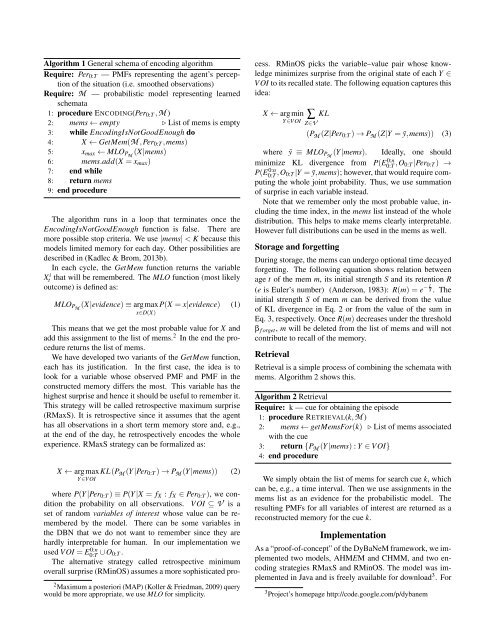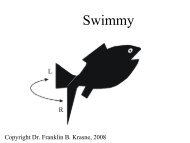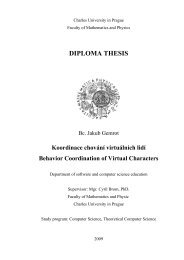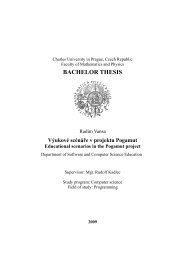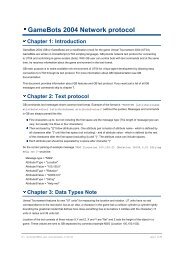DyBaNeM: Bayesian Framework for Episodic Memory Modelling
DyBaNeM: Bayesian Framework for Episodic Memory Modelling
DyBaNeM: Bayesian Framework for Episodic Memory Modelling
You also want an ePaper? Increase the reach of your titles
YUMPU automatically turns print PDFs into web optimized ePapers that Google loves.
Algorithm 1 General schema of encoding algorithm<br />
Require: Per 0:T — PMFs representing the agent’s perception<br />
of the situation (i.e. smoothed observations)<br />
Require: M — probabilistic model representing learned<br />
schemata<br />
1: procedure ENCODING(Per 0:T ,M )<br />
2: mems ← empty ⊲ List of mems is empty<br />
3: while EncodingIsNotGoodEnough do<br />
4: X ← GetMem(M ,Per 0:T ,mems)<br />
5: x max ← MLO PM (X|mems)<br />
6: mems.add(X = x max )<br />
7: end while<br />
8: return mems<br />
9: end procedure<br />
The algorithm runs in a loop that terminates once the<br />
EncodingIsNotGoodEnough function is false. There are<br />
more possible stop criteria. We use |mems| < K because this<br />
models limited memory <strong>for</strong> each day. Other possibilities are<br />
described in (Kadlec & Brom, 2013b).<br />
In each cycle, the GetMem function returns the variable<br />
Xt i that will be remembered. The MLO function (most likely<br />
outcome) is defined as:<br />
MLO PM (X|evidence) ≡ argmaxP(X = x|evidence) (1)<br />
x∈D(X)<br />
This means that we get the most probable value <strong>for</strong> X and<br />
add this assignment to the list of mems. 2 In the end the procedure<br />
returns the list of mems.<br />
We have developed two variants of the GetMem function,<br />
each has its justification. In the first case, the idea is to<br />
look <strong>for</strong> a variable whose observed PMF and PMF in the<br />
constructed memory differs the most. This variable has the<br />
highest surprise and hence it should be useful to remember it.<br />
This strategy will be called retrospective maximum surprise<br />
(RMaxS). It is retrospective since it assumes that the agent<br />
has all observations in a short term memory store and, e.g.,<br />
at the end of the day, he retrospectively encodes the whole<br />
experience. RMaxS strategy can be <strong>for</strong>malized as:<br />
X ← argmaxKL(P M (Y |Per 0:T ) → P M (Y |mems)) (2)<br />
Y ∈VOI<br />
where P(Y |Per 0:T ) ≡ P(Y |X = f X : f X ∈ Per 0:T ), we condition<br />
the probability on all observations. VOI ⊆ V is a<br />
set of random variables of interest whose value can be remembered<br />
by the model. There can be some variables in<br />
the DBN that we do not want to remember since they are<br />
hardly interpretable <strong>for</strong> human. In our implementation we<br />
used VOI = E0:T 0:n ∪ O 0:T .<br />
The alternative strategy called retrospective minimum<br />
overall surprise (RMinOS) assumes a more sophisticated pro-<br />
2 Maximum a posteriori (MAP) (Koller & Friedman, 2009) query<br />
would be more appropriate, we use MLO <strong>for</strong> simplicity.<br />
cess. RMinOS picks the variable–value pair whose knowledge<br />
minimizes surprise from the original state of each Y ∈<br />
VOI to its recalled state. The following equation captures this<br />
idea:<br />
X ← argmin<br />
Y ∈VOI<br />
∑<br />
Z∈V<br />
KL<br />
(P M (Z|Per 0:T ) → P M (Z|Y = ȳ,mems)) (3)<br />
where ȳ ≡ MLO PM (Y |mems). Ideally, one should<br />
minimize KL divergence from P(E0:T 0:n,O<br />
0:T |Per 0:T ) →<br />
P(E0:T 0:n,O<br />
0:T |Y = ȳ,mems); however, that would require computing<br />
the whole joint probability. Thus, we use summation<br />
of surprise in each variable instead.<br />
Note that we remember only the most probable value, including<br />
the time index, in the mems list instead of the whole<br />
distribution. This helps to make mems clearly interpretable.<br />
However full distributions can be used in the mems as well.<br />
Storage and <strong>for</strong>getting<br />
During storage, the mems can undergo optional time decayed<br />
<strong>for</strong>getting. The following equation shows relation between<br />
age t of the mem m, its initial strength S and its retention R<br />
(e is Euler’s number) (Anderson, 1983): R(m) = e − t S . The<br />
initial strength S of mem m can be derived from the value<br />
of KL divergence in Eq. 2 or from the value of the sum in<br />
Eq. 3, respectively. Once R(m) decreases under the threshold<br />
β f orget , m will be deleted from the list of mems and will not<br />
contribute to recall of the memory.<br />
Retrieval<br />
Retrieval is a simple process of combining the schemata with<br />
mems. Algorithm 2 shows this.<br />
Algorithm 2 Retrieval<br />
Require: k — cue <strong>for</strong> obtaining the episode<br />
1: procedure RETRIEVAL(k,M )<br />
2: mems ← getMemsFor(k) ⊲ List of mems associated<br />
with the cue<br />
3: return {P M (Y |mems) : Y ∈ VOI}<br />
4: end procedure<br />
We simply obtain the list of mems <strong>for</strong> search cue k, which<br />
can be, e.g., a time interval. Then we use assignments in the<br />
mems list as an evidence <strong>for</strong> the probabilistic model. The<br />
resulting PMFs <strong>for</strong> all variables of interest are returned as a<br />
reconstructed memory <strong>for</strong> the cue k.<br />
Implementation<br />
As a “proof-of-concept” of the <strong>DyBaNeM</strong> framework, we implemented<br />
two models, AHMEM and CHMM, and two encoding<br />
strategies RMaxS and RMinOS. The model was implemented<br />
in Java and is freely available <strong>for</strong> download 3 . For<br />
3 Project’s homepage http://code.google.com/p/dybanem


